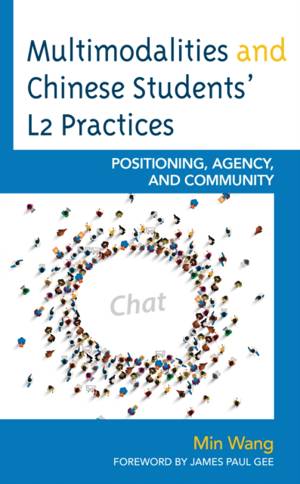
- Afhalen na 1 uur in een winkel met voorraad
- Gratis thuislevering in België vanaf € 30
- Ruim aanbod met 7 miljoen producten
- Afhalen na 1 uur in een winkel met voorraad
- Gratis thuislevering in België vanaf € 30
- Ruim aanbod met 7 miljoen producten
Zoeken
Multimodalities and Chinese Students' L2 Practices
Positioning, Agency, and Community
Min Wang
Hardcover | Engels
€ 178,45
+ 356 punten
Omschrijving
Multimodalities and Chinese Students' L2 Practices: Identity, Community, and Literacy explores the complex relations and interactions among multimodality, positioning, and agency in increasingly digitized, multilingual, and multicultural contexts. Min Wang uses interview narratives, WeChat exchanges, and class observations and field notes of three Chinese international students' lived experiences of English learning to show that these L2 learners recognized and appropriated multiple modes and digital tools for their L2 literacies practices. They used multimodalities to position themselves as L2 users who are confident, able, and competent, but sometimes also struggling and ambivalent. The practice of meaning-making, remaking, designing, and redesigning demonstrated their agency as L2 learners. Positioned as cultural and social beings, these L2 learners presented their self-understandings and self-representations through symbolic and material artifacts, interactions with local and non-local people, and engagement in WeChat discussions and ELI learning. They assumed rights, obligations, and expectations in order to become legitimate community members. In the process their agency was promoted, negotiated, or sometimes limited by micro-social structures and ongoing interactions.
Specificaties
Betrokkenen
- Auteur(s):
- Uitgeverij:
Inhoud
- Aantal bladzijden:
- 180
- Taal:
- Engels
Eigenschappen
- Productcode (EAN):
- 9781498594561
- Verschijningsdatum:
- 13/03/2020
- Uitvoering:
- Hardcover
- Formaat:
- Genaaid
- Afmetingen:
- 152 mm x 229 mm
- Gewicht:
- 435 g

Alleen bij Standaard Boekhandel
+ 356 punten op je klantenkaart van Standaard Boekhandel
Beoordelingen
We publiceren alleen reviews die voldoen aan de voorwaarden voor reviews. Bekijk onze voorwaarden voor reviews.











